Installation Verification
This chapter explains about OSI IVP used to check that OpenFrame OSI has been properly installed.
1. Overview
Installation Verification Procedure (IVP) helps you to verify that the system has been constructed normally and that basic functions are run properly during system installation. Administrators should check every issue that occurs in system, but the problem solving is more easy and intuitive when using IVP.
2. OSI IVP
OSI IVP is installed by using an installer. The associated sample files can be checked in OpenFrame/osi/oivp.
The following section will describe how to configure a region of OSI IVP, register an application, and verify the installation of OpenFrame OSI.
2.1. Configuration
Resources for region (IMSA) configuration, the user server, and OSI data sets to operate OIVP are automatically created. The basic installation files required for all registration procedures are provided by the installer. To operate OSI IVP normally, it is recommended to use the installation file without modification.
The following are the steps for setting the system, user servers and related resources.
-
Create a system server
Create the system server and the services used by the server in the Tmax configuration file.
-
Create a user server
Register the user server and the services used by the server in the Tmax configuration file.
-
Register associated resources
The osi_define.sh script contained in the installer is used to register the dataset.
Verify the automatically installed items in the installation properties file. If necessary, you can manually execute and verify the script.
The $OPENFRAME_HOME/scripts/osi_define.sh command is used to set an IMSA region after installing the product. The dataset can be created using the idcams tool.
$ OPENFRAME_HOME/scripts/osi_define.shThe following shows the execution of the shell.
idcams define -t CL -n OSI.IMSA.DEFLIB -o KS -k 10,0 -l 100,32760 -s 1024,128,128 -v DEFVOL ${OPENFRAME_HOME}/bin/osisdgen osi_sdlib_COBOL.dat IMSAFor more information about the system server configuration, user server configuration, and data set creation, refer to OpenFrame OSI Administrator’s Guide.
2.2. Registering Applications
When the configuration is complete, you should register MAP and COBOL source code after compiling them.
You can compile and register the Map and COBOL source code by following the steps below. They can be automatically installed by using an installer.
-
Compiling a Map
Copy and compile the Map files used by OSI IVP.
The following $OPENFRAME_HOME/scripts/osi_ivp.sh script contains the command to create OSI IVP MAP.
$ OPENFRAME_HOME/scripts/osi_ivp.shThe following shows the Map file compilation of the shell.
#mapgen cd ${OPENFRAME_HOME}/osi/oivp/mfs/COBOL ${OPENFRAME_HOME}/bin/osimfsgen -m OSI.IMSA.MFSLIB OIVP001.TXT ${OPENFRAME_HOME}/bin/osimfsgen -m OSI.IMSA.MFSLIB OIVP002.TXT ${OPENFRAME_HOME}/bin/osimfsgen -m OSI.IMSA.MFSLIB OIVP003.TXT ${OPENFRAME_HOME}/bin/osimfsgen -m OSI.IMSA.MFSLIB OIVP004.TXT ${OPENFRAME_HOME}/bin/osimfsgen -m OSI.IMSA.MFSLIB OIVP005.TXT ${OPENFRAME_HOME}/bin/osimfsgen -m OSI.IMSA.MFSLIB OIVP006.TXT ${OPENFRAME_HOME}/bin/osimfsgen -m OSI.IMSA.MFSLIB OIVP014.TXT ${OPENFRAME_HOME}/bin/osimfsgen -m OSI.IMSA.MFSLIB OIVP015.TXT ${OPENFRAME_HOME}/bin/osimfsgen -m OSI.IMSA.MFSLIB OIVP024.TXT -
Compiling COBOL source code
Compile the COBOL source file used by OSI IVP.
The compilation uses the $OPENFRAME_HOME/osi/oivp/compile.sh script.
$ OPENFRAME_HOME/osi/oivp/src/compile.shThe following shows the main executions of the shell. (COBOL sample source)
ofcob --enable-cbltdli --force-trace -o ${base}.so ${base}.cob -
Registering the resource information and mapping the data structure
IVP resource information (osi_sdlib.dat) is registered and data structure mapping is performed.
$ OPENFRAME_HOME/scripts/osi_define.shThe following example shows the resource information registration of the shell.
#REGISTER SYSTEM DEFINITION cd ${OPENFRAME_HOME}/osi/resource/data ${OPENFRAME_HOME}/bin/vtamgen vtam.dat ${OPENFRAME_HOME}/bin/osisdgen osi_sdlib_COBOL.dat IMSA -
Booting OSI system
The following command is used to boot the OSI system.
TMBOOT for node(NODE1) is starting: Welcome to Tmax demo system: it will expire 2018/9/10 Today: 2018/9/8 TMBOOT: TMM is starting: Sat Sep 8 18:59:33 2018 TMBOOT: CLL is starting: Sat Sep 8 18:59:33 2018 TMBOOT: CLH is starting: Sat Sep 8 18:59:33 2018 TMBOOT: TLM(tlm) is starting: Sat Sep 8 18:59:33 2018 20180908:185933 I OSI7061I [20: OSIBOOT: 0: 6330: 79] System server(ofrsasvr) booting ok 20180908:185933 I OSI7061I [20: OSIBOOT: 0: 6330: 79] System server(ofrlhsvr) booting ok 20180908:185933 I OSI7061I [20: OSIBOOT: 0: 6330: 79] System server(ofrdmsvr) booting ok 20180908:185933 I OSI7061I [20: OSIBOOT: 0: 6330: 79] System server(ofrdsedt) booting ok 20180908:185933 I OSI7061I [20: OSIBOOT: 0: 6330: 79] System server(ofrcmsvr) booting ok 20180908:185933 I OSI7061I [20: OSIBOOT: 0: 6330: 79] System server(ofruisvr) booting ok 20180908:185933 I OSI7061I [20: OSIBOOT: 0: 6330: 79] System server(ofrsmlog) booting ok 20180908:185933 I OSI7061I [20: OSIBOOT: 0: 6330: 79] System server(vtammgr) booting ok 20180908:185933 I OSI7061I [20: OSIBOOT: 0: 6330: 79] System server(ofrpmsvr) booting ok 20180908:185933 I OSI7061I [20: OSIBOOT: 0: 6330: 79] System server(obmjmsvr) booting ok 20180908:185933 I OSI7061I [20: OSIBOOT: 0: 6330: 79] System server(obmjinit) booting ok 20180908:185933 I OSI7061I [20: OSIBOOT: 0: 6330: 79] System server(obmjschd) booting ok 20180908:185933 I OSI7061I [20: OSIBOOT: 0: 6330: 79] System server(obmjhist) booting ok 20180908:185933 I OSI7061I [20: OSIBOOT: 0: 6330: 79] System server(obmjspbk) booting ok 20180908:185933 I OSI7061I [20: OSIBOOT: 0: 6330: 79] System server(obmtsmgr) booting ok 20180908:185933 I OSI7061I [20: OSIBOOT: 0: 6330: 79] System server(obmjtimr) booting ok 20180908:185933 I OSI7061I [20: OSIBOOT: 0: 6330: 79] System server(tmsvr) booting ok 20180908:185933 I OSI7061I [20: OSIBOOT: 0: 6330: 79] System server(OSIGW001) booting ok 20180908:185933 I OSI7051I [20: OSIBOOT: 0: 6330: 277] Booting process complete.The following command is used to boot the default region (IMSA).
$ tjesmgr r IMSACTL Input USERNAME : ROOT > Command : [r IMSACTL] Node name : A N Y (JOB00541) /home/oframe6/OpenFrame/volume_DEFVOL/SYS1.JCLLIB/IMSACTL is submitted as IMSACTL(JOB00541). $ imscmd IMSA /NRE IMS control region : [IMSA] Requested command : [NRE] ---------------------------------------- NRESTART COMMAND IN PROGRESS *21098/191312* ---------------------------------------- Command '/NRE' execution done $ imscmd IMSA /START DC IMS control region : [IMSA] Requested command : [START DC] ---------------------------------------- START COMMAND COMPLETED *21098/191315* ---------------------------------------- Command '/START DC' execution done $ imscmd IMSA /START REGION IMSAMSG IMS control region : [IMSA] Requested command : [START REGION IMSAMSG] ---------------------------------------- START COMMAND COMPLETED *21098/191318* ---------------------------------------- Command '/START REGION IMSAMSG' execution done
|
For more information about map compilation, COBOL source code compilation, and engine startup, refer to OpenFrame OSI Administrator’s Guide. |
2.3. Verifying Installation
The verification through OSI IVP is divided into Message Processing Program (MPP) verification and Batch Message Processing Program (BMP) verification.
-
IVP verifies the program that process messages in an online environment, and checks the processing details according to the procedure.
-
Actual data management. OSI can access the user dataset. The user verifies job execution results by starting JCL, without having to process the data accumulated in the message queue in real time.
2.3.1. MPP Verification
OSI IVP verifies the OSI resources and commands using the applications that manage personal information. To start OSI IVP, access the OSI system through the terminal and call the IVP program by executing the /FOR command.
Access the OSI system through the terminal as follows.
IMSA <ENTER>
Call the IVP program as follows after accessing the OSI system. (COBOL sample code)
<CLEAR> /FOR OIVP001O <ENTER>
The followings list contains every key used in each screen of IVP and its function.
| Key | Function | Screen |
|---|---|---|
CLEAR |
Displays the start screen |
Full |
ENTER |
Proceeds to the next step |
Full |
The following is the OSI IVP start screen.
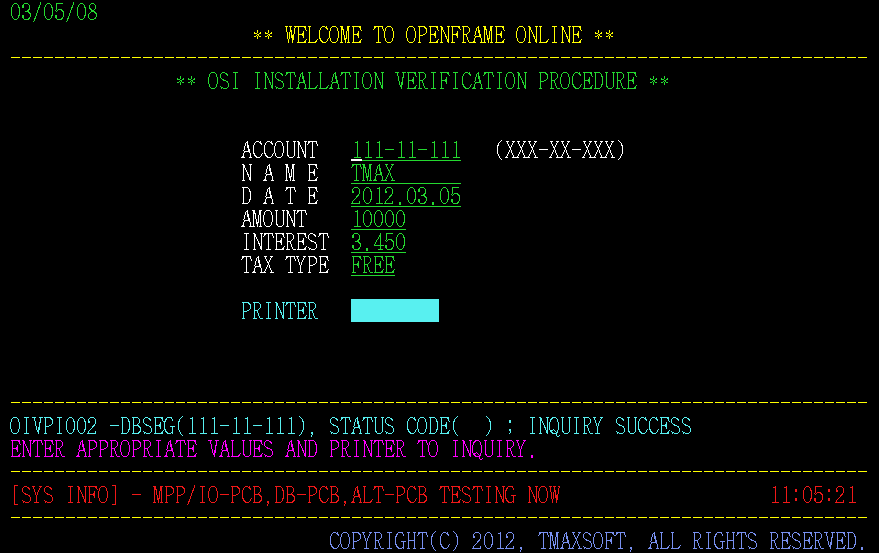
The OSI IVP screen can be divided into three sections.
-
Top
Displays date and time, and terminal information provided in OpenFrame.
-
Center
Actual IVP applications are executed.
-
Bottom
Displays copyright.
OSI IVP has four menus (INQR, INSR, UPDT, DELT), and you can access the menu by entering CODE.
|
As INQR, UPDT, and DELT are executable only when FILE has a record, you should enter records first by using INSR. |
-
INQR Screen
The INQR screen shows a specific record stored in the file. Access the menu from the start screen by entering CODE. If an incorrect CODE is entered, an error will occur.
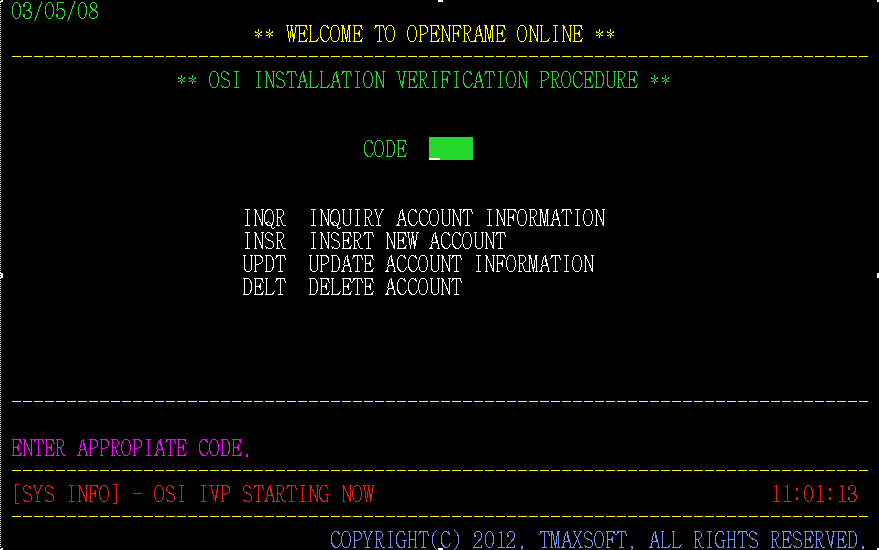 OSI IVP INQR Screen
OSI IVP INQR Screen -
INSR Screen
Enter a new record in the INSR screen. Each field of the record is composed of ACCOUNT, NAME, DATE, AMOUNT, INTEREST, and TAX TYPE. Enter each field value and register them.
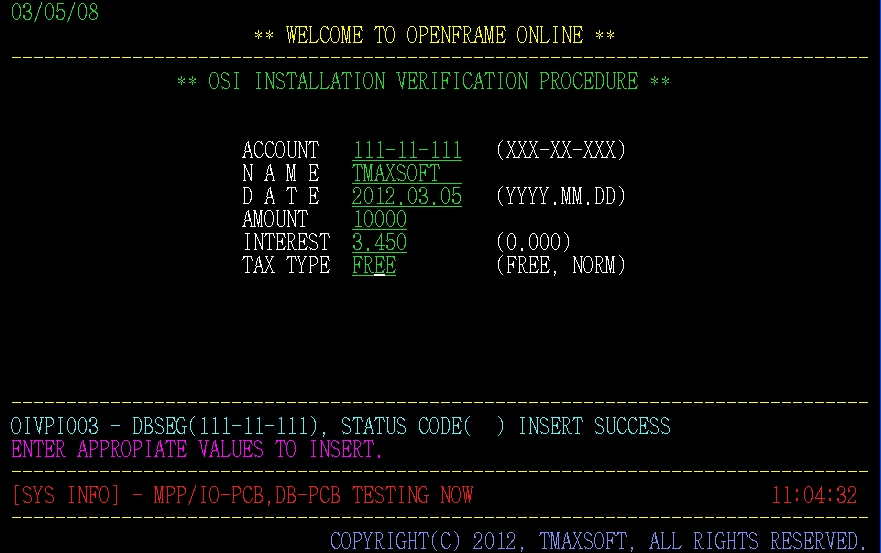 OSI IVP INSR Screen
OSI IVP INSR Screen -
UPDT Screen
Edit the existing records in the UPDT screen. Access the menu from the start screen by entering CODE. If an incorrect CODE is entered, an error will occur.
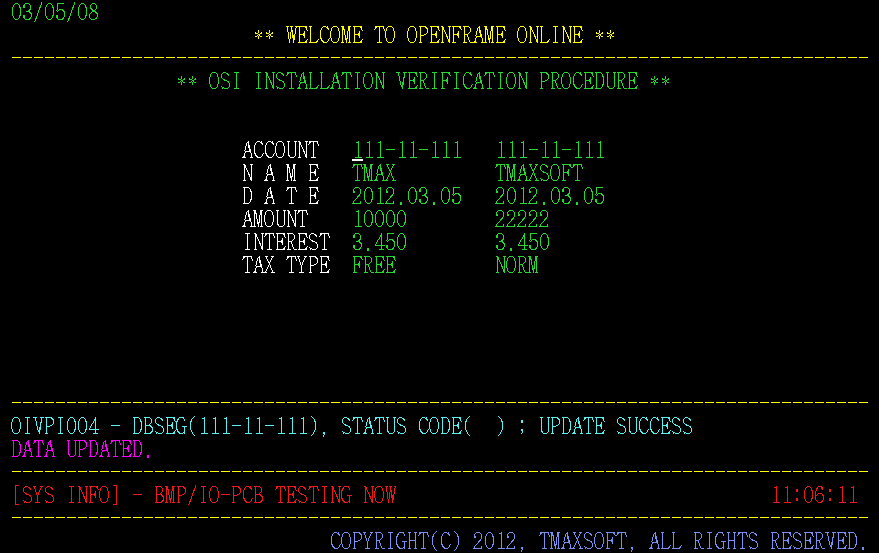 OSI IVP UPDT Screen
OSI IVP UPDT Screen -
DELT Screen
Delete the existing records in the DELETE screen. Access the menu from the start screen by entering the CODE. If an incorrect CODE is entered, an error will occur.
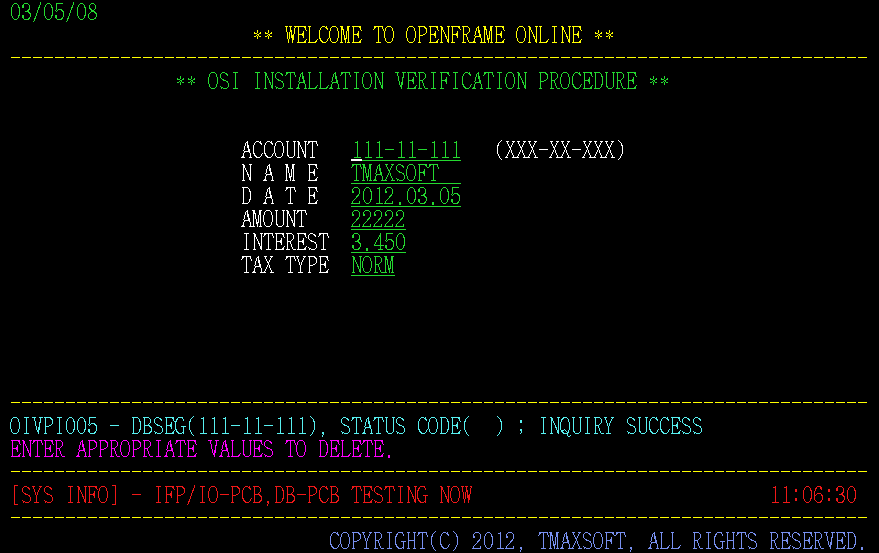 OSI IVP DELT Screen
OSI IVP DELT Screen
2.3.2. BMP Verification
BMP verification is used to check the messages stored in dataset. Execute the JOB using the tjesmgr tool and check the log information.
The following example shows how to use BMP that performs JCL with the tjesmgr command.
-
Execute tjesmgr.
$ tjesmgr -
Execute the boot command to execute JCL and run IMSABMP2.
Tmax JES Manager 7.1 +-------------------------------------------------------------------------------- | | JOB ID : JOB00543 NODE NAME : NODE1 | JOB NAME : OSIBMPT | JOB CLASS : A , JOB STATUS : Done(R00000) , JOB PRTY : 5 , JCLRUNNER INDEX : 5 | JOB USER : ROOT | JCL PATH : /home/oframe6/OpenFrame/volume_DEFVOL/SYS1.JCLLIB/IMSABMP2 | TIME STAMP : READY : 20210408/19:14:29, START : 20210408/19:14:30 | END : 20210408/19:14:31 | RES USAGE : PROCESS - 1s CPU - (0s,0%) MEM - 0Byte | | STEP LIST : | ---------------------------------------------------------------------------- | [ TSTEP1] START : 20210408/19:14:30, RC=R0000, CPU - 0s (0s) | ---------------------------------------------------------------------------- | | SPOOL LIST : | --------------------------------------------------------------------------- | NO STEP DDNAME SIZE DSNAME | --------------------------------------------------------------------------- | 0 -------- INPJCL 214 INPJCL | 1 -------- SYSMSG 1K SYSMSG | 2 -------- CATPROC 0 CATPROC | 3 -------- CONVJCL 211 CONVJCL | 4 -------- JESMSG 730 JESMSG | 5 -------- JESJCL 824 JESJCL | 6 TSTEP1 SYSOUT 2K oframe6.OSIBMPT.JOB00543.D000001 | ----------------------------------------------------------------------------- | | OUTPUT PROCESSING STATUS : all outputs were processed
-
Verify the INQR information using the PODD @j di=5 command of tjesmgr, and verify the update condition.
|Command : [podd @j di=5] [2021-04-08T19:14:30.609042] [DFSRRC00(16835) ] [M] [RRC0901M] DFSRRC00 PROGRAM START [2021-04-08T19:14:30.609077] [DFSRRC00(16835) ] [M] [RRC0903M] INITIALIZE BMP REGION [2021-04-08T19:14:30.609226] [DFSRRC00(16835) ] [M] [RRC0906M] SHARED OBJECT TYPE [2021-04-08T19:14:30.609626] [DFSRRC00(16835) ] [M] [RRC0921M] CHILD PROCESSID - pid=16841 [2021-04-08T19:14:30.609827] [DFSRRC00(16841) ] [D] [DEBUGP1D] path=/home/oframe6/OpenFrame/core//appbin/osibmpsv [2021-04-08T19:14:30.649096] [osibmpsv(16841) ] [M] [OSI0291M] IMSA server boots - resource manager initialization starts [2021-04-08T19:14:30.650632] [osibmpsv(16841) ] [M] [OSI0101M] osimfs version: 7.2.0(4) obuild@tplinux64:ofsrc71/osi(#1) 2021-03-26 14:11:10 [2021-04-08T19:14:30.652909] [osibmpsv(16841) ] [M] [OSI0291M] IMSA server boots - resource manager initialization completed [2021-04-08T19:14:30.671149] [osibmpsv(16841) ] [M] [OSI5251M] osibmpsv initialization ok [2021-04-08T19:14:30.671185] [osibmpsv(16841) ] [M] [OSI5263M] DFSRRC00 PARM : MBR=OIVPIL02 [2021-04-08T19:14:30.671192] [osibmpsv(16841) ] [M] [OSI5263M] DFSRRC00 PARM : PSB=OIVPIL02 [2021-04-08T19:14:30.671197] [osibmpsv(16841) ] [M] [OSI5263M] DFSRRC00 PARM : IN=OIVPBMP2 [2021-04-08T19:14:30.671203] [osibmpsv(16841) ] [M] [OSI5263M] DFSRRC00 PARM : OUT= [2021-04-08T19:14:30.671208] [osibmpsv(16841) ] [M] [OSI5263M] DFSRRC00 PARM : IMSID=IMSA [2021-04-08T19:14:30.671216] [osibmpsv(16841) ] [M] [OSI5263M] DFSRRC00 PARM : AGN= [2021-04-08T19:14:30.684645] [osibmpsv(16841) ] [M] [OSI2010M] pgmpath : /home/oframe6/OpenFrame/volume_DEFVOL/OSI.IMSA.STEPLIB/OIVPIL02.so MSG-COUNT : [00001] BEFORE GU MESSAGE EXIST ------------------[ INQUIRY ]------------------- ACCOUNT : [ ] ------------------------------------------------ MSG-COUNT : [00002] BEFORE GU MESSAGE EXIST MSG-COUNT : [00001] BEFORE GU MESSAGE NOT EXIST [2021-04-08T19:14:30.749841] [osibmpsv(16841) ] [M] [OSI0202M] IMSA server downs - resource manager finalization starts [2021-04-08T19:14:30.749893] [osibmpsv(16841) ] [M] [OSI0202M] IMSA server downs - resource manager finalization completed [2021-04-08T19:14:30.752047] [DFSRRC00(16835) ] [M] [RRC0922M] CHILD TERMINATE - RC=R0000 [2021-04-08T19:14:30.756974] [DFSRRC00(16835) ] [M] [RRC0902M] DFSRRC00 PROGRAM FINISH
|
For more information about the TJES utility, refer to OpenFrame Batch TJES Guide. |